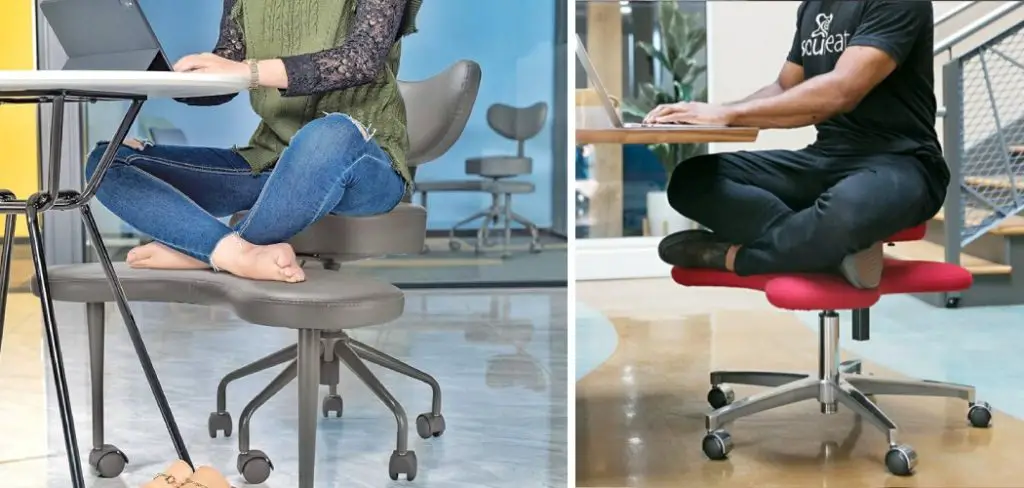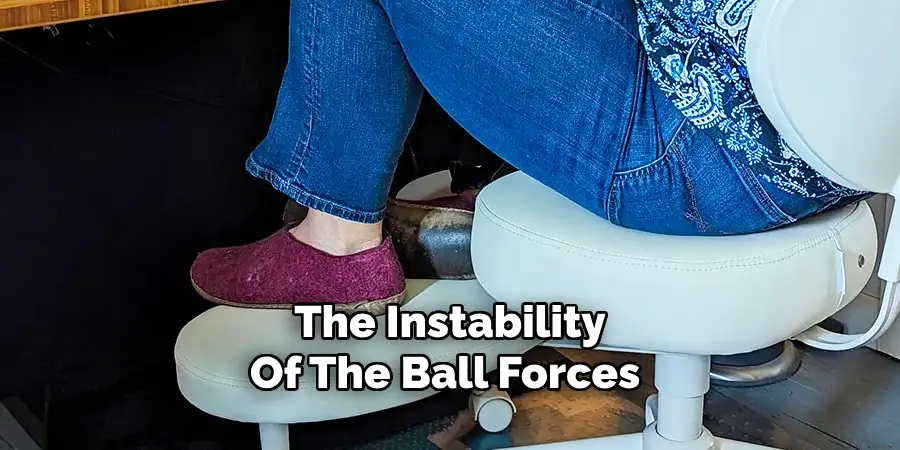Sitting cross-legged at your desk may feel comfortable initially, but it can lead to a range of health issues over time. Constantly crossing your legs can contribute to poor posture, back pain, and even circulatory problems. Moreover, it may create an imbalance in your muscles and joints, leading to discomfort and potential long-term issues. Recognizing the impact of this common habit is the first step toward making healthier sitting choices.

This guide on how to stop crossing legs at desk will provide practical tips and techniques to help you break the habit of crossing your legs while working at your desk, ultimately promoting better posture and overall well-being.
Why Do We Cross Our Legs?
Crossing legs is an ingrained habit for many of us, and it can be a hard one to break. Most commonly, people cross their legs while sitting because it feels comfortable or helps them feel more stable in their seat. It may also be a subconscious way to relieve tension or restlessness.
However, crossing your legs at the desk can lead to several physical issues that can affect your overall health. When you sit with your legs crossed, the pelvis tilts and puts pressure on your spine, causing strain and discomfort in your lower back. This posture also compresses nerves and blood vessels in the leg and foot, leading to numbness and decreased circulation.
Needed Materials
- Comfortable Chair With Good Lumbar Support
- Adjustable Desk or Keyboard Tray to Maintain Proper Arm and Wrist Position
- Footrest (If Necessary)
8 Step-by-step Guidelines on How to Stop Crossing Legs at Desk
Step 1: Create Awareness
The first step to breaking any habit is recognizing it. Pay attention to your sitting posture and note how often you find yourself crossing your legs. Set a reminder on your phone or use a Post-it note on your desk as a visual cue to remind you not to cross your legs.
The more aware you are of the habit, the easier it will be to change it.

Step 2: Sit with Both Feet on the Ground
Start by keeping both feet planted firmly on the ground. This position helps distribute your weight evenly and maintain proper spine alignment. Use a footrest if your feet do not comfortably rest on the floor.
But be mindful not to place too much pressure on your feet. Keep them relaxed and avoid pushing down on the footrest too hard.
Step 3: Adjust Your Chair
Make sure your chair has good lumbar support to maintain the natural curve of your spine. Use a lumbar cushion if necessary, or adjust the backrest to provide proper support.
Also, check that your chair is at a suitable height so that your arms are parallel to the ground when typing or using the mouse. This will help prevent slouching and leaning forward, which can lead to crossing legs for stability.
Step 4: Sit with Hips Slightly Higher than Knees
To further promote a neutral pelvis and spine, adjust your chair’s height so that your hips are slightly higher than your knees. This position also helps maintain proper circulation in the legs. It may take some trial and error to find the right chair height, so be patient and experiment.
But remember, your feet should still be comfortably resting on the ground or footrest.
Step 5: Practice Mindful Breathing
When you feel the urge to cross your legs, try taking a few deep breaths instead. This can help release tension and restlessness without compromising your posture. Take slow, deliberate breaths, and focus on relaxing any tense muscles in your body.
The added bonus is that deep breathing can also help reduce stress and improve focus.
Step 6: Use a Stability Ball
Sitting on a stability ball or exercise ball can be an effective way to break the habit of crossing your legs. The instability of the ball forces you to engage your core muscles and maintain proper posture, making it difficult to cross your legs.

If using a stability ball as a desk chair, make sure it is properly sized for your height. Your feet should still comfortably rest on the ground, and your knees should be at a 90-degree angle.
Step 7: Take Frequent Breaks
Incorporating regular breaks into your work routine is essential for maintaining good posture and preventing the urge to cross your legs. Aim to stand up and move around for a few minutes every hour. This practice not only reduces physical strain from prolonged sitting but also encourages better circulation and reduces fatigue. Use these breaks to stretch your legs, walk around the office, or even perform light exercises to re-energize your muscles.
Setting a timer or using an app to remind you to take breaks can be a helpful way to stay consistent. Regular breaks will help prevent stiffness and promote overall well-being, making it easier to maintain a healthy sitting posture throughout the day.
Step 8: Be Patient and Persistent
Breaking any habit takes time and effort, so be patient with yourself. It may take a while to adjust to sitting without crossing your legs, but consistency is key. Keep reminding yourself of the potential health risks and benefits of maintaining good posture.
Additionally, try incorporating other healthy habits into your daily routine, such as regular exercise and proper hydration, to support your overall well-being and reduce the urge to cross your legs.
Following these steps on how to stop crossing your legs at your desk and being persistent in your efforts will ultimately help you break the habit of crossing your legs at your desk, leading to better posture and long-term health benefits. Remember to be kind to yourself throughout the process, as small changes can make a significant impact on your overall well-being. So start practicing these techniques today and enjoy the benefits of healthier sitting habits! Keep sitting comfortably, but most importantly, sit smartly.
Additional Tips for Maintaining Good Posture at the Desk

- Keep your computer or laptop screen at eye level to avoid straining your neck.
- Take regular breaks to stand, stretch, and walk around.
- Use a standing desk or alternate between sitting and standing throughout the day.
- Consider using an ergonomic keyboard and mouse to reduce strain on your wrists.
- Avoid slouching or leaning forward while typing or using the mouse.
- Stay hydrated and incorporate regular exercise into your daily routine for overall well-being.
With these additional tips, you can maintain good posture at your desk and prevent future discomfort and health issues. Remember, small changes in your sitting habits can have a significant impact on your overall health, so stay mindful of how you sit and make adjustments as needed. Your body will thank you in the long run! Happy sitting!
Frequently Asked Questions
Q: Is Crossing Your Legs Really That Bad for Your Health?
A: Yes, crossing your legs can lead to many potential health issues, including joint pain, nerve damage, and posture problems. It’s essential to break this habit and maintain a healthy sitting position at your desk.
Q: Can I Still Cross My Legs Occasionally?
A: It’s recommended to avoid crossing your legs altogether, but if you do feel the urge to cross them, try switching which leg is on top or alternate between crossing at the ankle and knee. However, be mindful not to make it a regular habit.
Q: Can I Use a Footrest Instead of Adjusting My Chair Height?
A: A footrest can help keep your feet flat on the ground and prevent crossing your legs, but it’s still essential to adjust your chair height for proper posture. The goal is to have your knees and hips at a 90-degree angle, with your feet comfortably resting on the ground or footrest.

Q: How Long Until I See Results from Breaking My Leg Crossing Habit?
A: Every person is different, so results may vary. However, with consistent effort and mindful practice, you should start to see improvements in your posture and overall well-being within a few weeks. Remember to be patient and persistent with your efforts.
Q: Can I Use These Techniques While Sitting in a Car or on Public Transportation?
A: Yes, these techniques can be applied to any sitting situation. It’s important to maintain good posture and avoid crossing your legs, even while traveling. Consider using a lumbar support cushion or adjusting your seat to support proper posture. So make it a habit to sit smartly no matter where you are!
Conclusion
Crossing your legs at the desk may seem like a harmless habit, but it can have negative consequences on your physical health. By following these steps on how to stop crossing legs at desk and making small adjustments to your workspace and routine, you can break this habit and maintain good posture while working at your desk.
Remember to be patient and persistent, and don’t forget to take breaks and practice mindful breathing throughout the day. Your body will thank you for it in the long run. So, let’s make a conscious effort to stop crossing our legs at the desk and prioritize our physical well-being. Happy sitting!
you can also check it out Sit on Sofa with Lower Back Pain
